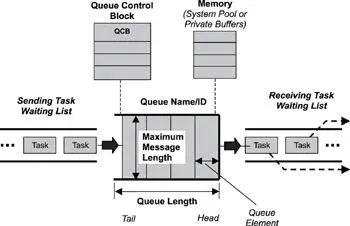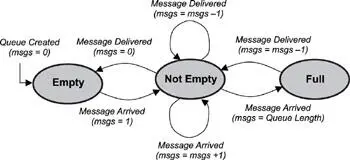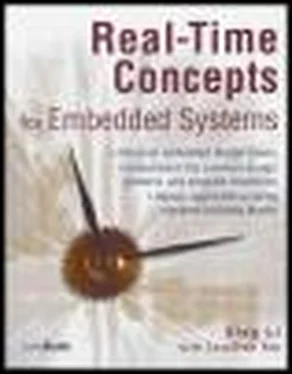7.2 Defining Message Queues
A message queue is a buffer-like object through which tasks and ISRs send and receive messages to communicate and synchornize with data. A message queue is like a pipeline. It temporarily holds messages from a sender until the intended receiver is ready to read them. This temporary buffering decouples a sending and receiving task; that is, it frees the tasks from having to send and receive messages simultaneously.
As with semaphore introduced in Chapter 6, a message queue has several associated components that the kernel uses to manage the queue. When a message queue is first created, it is assigned an associated queue control block (QCB), a message queue name, a unique ID, memory buffers, a queue length, a maximum message length, and one or more task-waiting lists, as illustrated in Figure 7.1.

Figure 7.1: A message queue, its associated parameters, and supporting data structures.
It is the kernel’s job to assign a unique ID to a message queue and to create its QCB and task-waiting list. The kernel also takes developer-supplied parameters-such as the length of the queue and the maximum message length-to determine how much memory is required for the message queue. After the kernel has this information, it allocates memory for the message queue from either a pool of system memory or some private memory space.
The message queue itself consists of a number of elements, each of which can hold a single message. The elements holding the first and last messages are called the head and tail respectively. Some elements of the queue may be empty (not containing a message). The total number of elements (empty or not) in the queue is the total length of the queue. The developer specified the queue length when the queue was created.
As Figure 7.1 shows, a message queue has two associated task-waiting lists. The receiving task-waiting list consists of tasks that wait on the queue when it is empty. The sending list consists of tasks that wait on the queue when it is full. Empty and full message-queue states, as well as other key concepts, are discussed in more detail next.
As with other kernel objects, message queues follow the logic of a simple FSM, as shown in Figure 7.2 When a message queue is first created, the FSM is in the empty state. If a task attempts to receive messages from this message queue while the queue is empty, the task blocks and, if it chooses to, is held on the message queue's task-waiting list, in either a FIFO or priority-based order.

Figure 7.2: The state diagram for a message queue.
In this scenario, if another task sends a message to the message queue, the message is delivered directly to the blocked task. The blocked task is then removed from the task-waiting list and moved to either the ready or the running state. The message queue in this case remains empty because it has successfully delivered the message.
If another message is sent to the same message queue and no tasks are waiting in the message queue's task-waiting list, the message queue's state becomes not empty.
As additional messages arrive at the queue, the queue eventually fills up until it has exhausted its free space. At this point, the number of messages in the queue is equal to the queue's length, and the message queue's state becomes full. While a message queue is in this state, any task sending messages to it will not be successful unless some other task first requests a message from that queue, thus freeing a queue element.
In some kernel implementations when a task attempts to send a message to a full message queue, the sending function returns an error code to that task. Other kernel implementations allow such a task to block, moving the blocked task into the sending task-waiting list, which is separate from the receiving task-waiting list.

Figure 7.3: Message copying and memory use for sending and receiving messages.
7.4 Message Queue Content
Message queues can be used to send and receive a variety of data. Some examples include:
· a temperature value from a sensor,
· a bitmap to draw on a display,
· a text message to print to an LCD,
· a keyboard event, and
· a data packet to send over the network.
Some of these messages can be quite long and may exceed the maximum message length, which is determined when the queue is created. (Maximum message length should not be confused with total queue length, which is the total number of messages the queue can hold.) One way to overcome the limit on message length is to send a pointer to the data, rather than the data itself. Even if a long message might fit into the queue, it is sometimes better to send a pointer instead in order to improve both performance and memory utilization.
When a task sends a message to another task, the message normally is copied twice, as shown in Figure 7.3 The first time, the message is copied when the message is sent from the sending task’s memory area to the message queue’s memory area. The second copy occurs when the message is copied from the message queue’s memory area to the receiving task’s memory area.
An exception to this situation is if the receiving task is already blocked waiting at the message queue. Depending on a kernel’s implementation, the message might be copied just once in this case-from the sending task’s memory area to the receiving task’s memory area, bypassing the copy to the message queue’s memory area.
Because copying data can be expensive in terms of performance and memory requirements, keep copying to a minimum in a real-time embedded system by keeping messages small or, if that is not feasible, by using a pointer instead.
7.5 Message Queue Storage
Different kernels store message queues in different locations in memory. One kernel might use a system pool, in which the messages of all queues are stored in one large shared area of memory. Another kernel might use separate memory areas, called private buffers, for each message queue.
Using a system pool can be advantageous if it is certain that all message queues will never be filled to capacity at the same time. The advantage occurs because system pools typically save on memory use. The downside is that a message queue with large messages can easily use most of the pooled memory, not leaving enough memory for other message queues. Indications that this problem is occurring include a message queue that is not full that starts rejecting messages sent to it or a full message queue that continues to accept more messages.
Using private buffers, on the other hand, requires enough reserved memory area for the full capacity of every message queue that will be created. This approach clearly uses up more memory; however, it also ensures that messages do not get overwritten and that room is available for all messages, resulting in better reliability than the pool approach.
7.6 Typical Message Queue Operations
Typical message queue operations include the following:
· creating and deleting message queues,
· sending and receiving messages, and
Читать дальше















